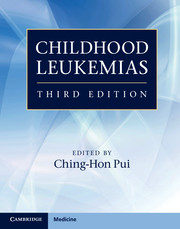Book contents
- Frontmatter
- Contents
- List of contributors
- Preface
- Section 1 History and general issues
- Section 2 Cell biology and pathobiology
- Section 3 Evaluation and treatment
- 12 Pharmacokinetic, pharmacodynamic, and pharmacogenetic considerations
- 13 Acute lymphoblastic leukemia
- 14 Relapsed acute lymphoblastic leukemia
- 15 B-cell acute lymphoblastic leukemia and Burkitt lymphoma
- 16 Acute myeloid leukemia
- 17 Relapsed acute myeloid leukemia
- 18 Myelodysplastic syndrome
- 19 Chronic myeloproliferative disorders
- 20 Leukemias in patients with Down syndrome
- 21 Treatment of adolescents and young adults with acute lymphoblastic leukemia
- 22 Hematopoietic stem cell and natural killer cell transplantation
- 23 Treatment of acute leukemia in countries with limited resources
- 24 Antibody-targeted therapy
- 25 Adoptive cellular immunotherapy
- 26 Gene transfer: methods and applications
- 27 Development therapeutics
- 28 Minimal residual disease
- Section 4 Complications and supportive care
- Index
- Plate Section
- References
17 - Relapsed acute myeloid leukemia
from Section 3 - Evaluation and treatment
Published online by Cambridge University Press: 05 April 2013
- Frontmatter
- Contents
- List of contributors
- Preface
- Section 1 History and general issues
- Section 2 Cell biology and pathobiology
- Section 3 Evaluation and treatment
- 12 Pharmacokinetic, pharmacodynamic, and pharmacogenetic considerations
- 13 Acute lymphoblastic leukemia
- 14 Relapsed acute lymphoblastic leukemia
- 15 B-cell acute lymphoblastic leukemia and Burkitt lymphoma
- 16 Acute myeloid leukemia
- 17 Relapsed acute myeloid leukemia
- 18 Myelodysplastic syndrome
- 19 Chronic myeloproliferative disorders
- 20 Leukemias in patients with Down syndrome
- 21 Treatment of adolescents and young adults with acute lymphoblastic leukemia
- 22 Hematopoietic stem cell and natural killer cell transplantation
- 23 Treatment of acute leukemia in countries with limited resources
- 24 Antibody-targeted therapy
- 25 Adoptive cellular immunotherapy
- 26 Gene transfer: methods and applications
- 27 Development therapeutics
- 28 Minimal residual disease
- Section 4 Complications and supportive care
- Index
- Plate Section
- References
Summary
Introduction
About 80 to 90% of children with newly diagnosed acute myeloid leukemia (AML) achieve complete remission (CR) with intensive induction chemotherapy. However, 10 to 20% of patients do not achieve remission, with early death from hemorrhage, leukostasis, infection, or resistant disease (primary refractory AML), and even after achieving remission, 30 to 40% of patients will relapse. Primary refractory AML and relapsed AML have a poor prognosis, with an overall survival of 25–35%. For patients in first relapse, the prognosis mainly depends on the time of relapse. If it is early, defined as within 1 year after initial diagnosis, the second CR rate is approximately 50% and overall survival 10–15%. If the time of relapse is late, defined as more than 1 year after diagnosis, the second CR rate is approximately 75% with an overall survival of up to 37%. Multiple-relapsed AML has an even worse prognosis. The management of refractory or relapsed AML is quite difficult. Several treatment schedules have been studied recently, and progress seems feasible with the use of new drugs and novel drug combinations followed by hematopoietic stem cell transplantation (HSCT).
Definition of relapse
Relapse is defined as the reappearance of leukemic cells at any site in the body. Most relapses in AML occur during treatment, mostly during the first year after diagnosis. Relapses after 2 years are rarely seen. Only exceptionally are relapses observed after more than 10 years, and in these patients it is uncertain whether the leukemic cells are the same clone found at diagnosis (relapse) or if they arose from a secondary (therapy-induced) leukemogenic event. This question is often difficult to resolve because of the lack of precise molecular and immunophenotypic techniques at the time the leukemia was first diagnosed.
- Type
- Chapter
- Information
- Childhood Leukemias , pp. 421 - 428Publisher: Cambridge University PressPrint publication year: 2012



